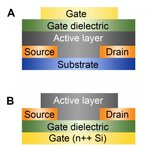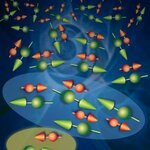Chemistry

New nanotechnology paints for walls, ceilings, and surfaces could be used to kill hospital superbugs when fluorescent lights are switched on, said scientists today at the Society for General Microbiology's Autumn meeting being held this week at Trinity College, Dublin.
The new paints contain tiny particles of titanium dioxide, which is the dazzling white compound often used as a brightener in commercial paints. It will also be familiar to tennis fans as the powder used for the white lines to mark out the courts at Wimbledon.
Scientists have discovered that extremely small, nanoparticle-sized…

Virginia Tech chemistry Professor Harry Dorn has developed a new area of fullerene chemistry that may be the backbone for development of molecular semiconductors and quantum computing applications.
Dorn plays with the hollow carbon molecules known as fullerenes as if they are tinker toys. First, in 1999, he figured out how to put atoms inside the 80-atom molecule, then how to do it reliably, how to change the number of atoms forming the carbon cage, and how to change the number and kinds of atoms inside the cage, resulting in a new, more sensitive MRI material and a vehicle to deliver…

Researchers from the National Institute of Standards and Technology (NIST) and Seoul National University (SNU) have learned how to tweak a new class of polymer-based semiconductors to better control the location and alignment of the components of the blend.
Their recent results—how to move the top to the bottom—could enable the design of practical, large-scale manufacturing techniques for a wide range of printable, flexible electronic displays and other devices.
Organic semiconductors—novel carbon-based molecules that have similar electrical properties to more conventional semiconducting…

LLNL researchers care about the environment too. To keep Mother Nature safe while we blow stuff up, they have added unique green solvents (ionic liquids) to an explosive called TATB (1,3,5-triamino-2,4,6-trinitrobenzene) and improved the crystal quality and chemical purity of the material.
Most explosives belong to a general class of materials called molecular crystals, which have become important building blocks in a number of other applications ranging from drugs, pigments, agrochemicals, dyes and optoelectronics. Many of these materials, including TATB, are bound together by a strong…

The semiconductor silicon and the ferromagnet iron are the basis for much of mankind's technology, used in everything from computers to electric motors.
Writing in Nature, an international group of scientists from the UK, USA and Lesotho report that they have combined these elements with a small amount of another common metal, manganese, to create a new material which is neither a magnet nor an ordinary semiconductor.
They then show how a small magnetic field can be used to switch ordinary semiconducting behavior (such as that seen in the electronic-grade silicon which is used to make…

A $2500 bottle of Château Latour wine that scored a 98 on the Wine Spectator point scale is not for amateurs. The sobering business of the high end wine trade involves scientists on a variety of different levels. One big problem is that wine—especially superb wine—goes bad. A chemist at U.C. Davis has found a way to tell if a bottle is fit for the Queen of England, or for the Queen of Wishful Thinking.
In the basement of the chemistry building at U.C. Davis, associate professor Matthew Augustine works with a unique nuclear magnetic resonance device of which there are only two in the U.S.…

Tetra-Amido Macrocyclic Ligands (TAMLs) are environmentally friendly catalysts with a host of applications for reducing and cleaning up pollutants, and a prime example of "green chemistry."
Carnegie Mellon University's Terry Collins, the catalyst's inventor, believes that the small-molecule catalysts have the potential to be even more effective than previously proven. Collins will discuss how iron-TAMLs (Fe-TAMLs) work and areas for further research, citing evidence from mechanistic and kinetic studies of the catalyst on Monday, Aug. 18 at the 236th national meeting of the American Chemical…

In chemistry, just as in life, threesomes do not break up neatly.
Open-minded thinkers may disagree and say that theoretically clean three-way splits can happen, but no one had actually witnessed one – until now.
A paper in the Aug. 8 issue of Science provides the first hard evidence for the simultaneous break-up of a molecule into three equal parts, called "concerted break-ups."
"The experiments by our collaborators (at the University of California, San Diego) demonstrated that this mechanism is present, and our theory explained why and how it happens," said co-author Anna Krylov, a…

Maxine Clarke highlights a bit of recent controversy regarding Open Notebook Science that has been bouncing around the blogosphere and FriendFeedosphere.
There are some who interpret the ongoing publication of our laboratory notebook as an expectation for the world to read it like a magazine. For someone who is not a collaborator or working in a related area that would make about as much sense as reading the phone book.
Here is an example of how an Open Notebook should be used:
Based on our Sitemeter records, this morning someone from the UK seached for "purification of phenylacetaldehyde"…

Terrace-like elevations of just a few nanometres can form during production of organic thin films made from electrically conductive material. This phenomenon was previously only known from inorganic materials and is crucially important for future production of a new generation of semi-conductor components based on organic thin films.
Inorganic semi-conductors have a simple construction and have made high-performance computers possible. In contrast, organic semi-conductors are complex but enable production of innovative electronic circuits, as vividly demonstrated by the first prototypes for…